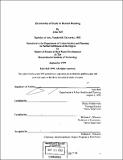| dc.contributor.advisor | Henry Pollakowski and William C. Wheaton. | en_US |
| dc.contributor.author | Bell, John (John E.), 1964- | en_US |
| dc.contributor.other | Massachusetts Institute of Technology. Dept. of Urban Studies and Planning. | en_US |
| dc.date.accessioned | 2011-06-20T15:49:06Z | |
| dc.date.available | 2011-06-20T15:49:06Z | |
| dc.date.copyright | 1999 | en_US |
| dc.date.issued | 1999 | en_US |
| dc.identifier.uri | http://hdl.handle.net/1721.1/64550 | |
| dc.description | Thesis (S.M.)--Massachusetts Institute of Technology, Dept. of Urban Studies and Planning, 1999. | en_US |
| dc.description | Includes bibliographical references (leaf 63). | en_US |
| dc.description.abstract | People believe that if there are economies of scale at the firm level, then there must also be economies at the asset level. But despite interest, there is no published research on the subject of asset level economies of scale. The Property Owners & Managers Survey, sponsored by HUD, is a national survey that for the first time allows a cross-sectional study of apartments. The survey provides data on geographic location, revenues, costs and management. Other surveys have focused on high end apartment complexes or low income housing. This survey looks at all levels of housing services and allows a study of property-level economies of scale that cover all levels of the apartment industry. Economic theory of the firm and its application to housing services is reviewed. The concept and theory of economies of scale are then applied to the apartment complex. Once the theory is reviewed, we look at empirical evidence from POMS to look at the relationship between operating costs and number of apartment units. The theory is empirically tested vis-a-vis a regression analysis using operating costs per apartment unit as the dependent variable and number of apartments as well as other variables as the independent variables. The regression is held constant to allow for a change in units. If economies of scale are present, then the operating costs per unit must decrease as units increase. A graphic representation of the equation demonstrates economies of scale over a limited data range. | en_US |
| dc.description.statementofresponsibility | by John Bell. | en_US |
| dc.format.extent | 63 leaves | en_US |
| dc.language.iso | eng | en_US |
| dc.publisher | Massachusetts Institute of Technology | en_US |
| dc.rights | M.I.T. theses are protected by
copyright. They may be viewed from this source for any purpose, but
reproduction or distribution in any format is prohibited without written
permission. See provided URL for inquiries about permission. | en_US |
| dc.rights.uri | http://dspace.mit.edu/handle/1721.1/7582 | en_US |
| dc.subject | Urban Studies and Planning. | en_US |
| dc.title | Economies of scale in rental housing | en_US |
| dc.type | Thesis | en_US |
| dc.description.degree | S.M. | en_US |
| dc.contributor.department | Massachusetts Institute of Technology. Department of Urban Studies and Planning | |
| dc.identifier.oclc | 45383817 | en_US |
